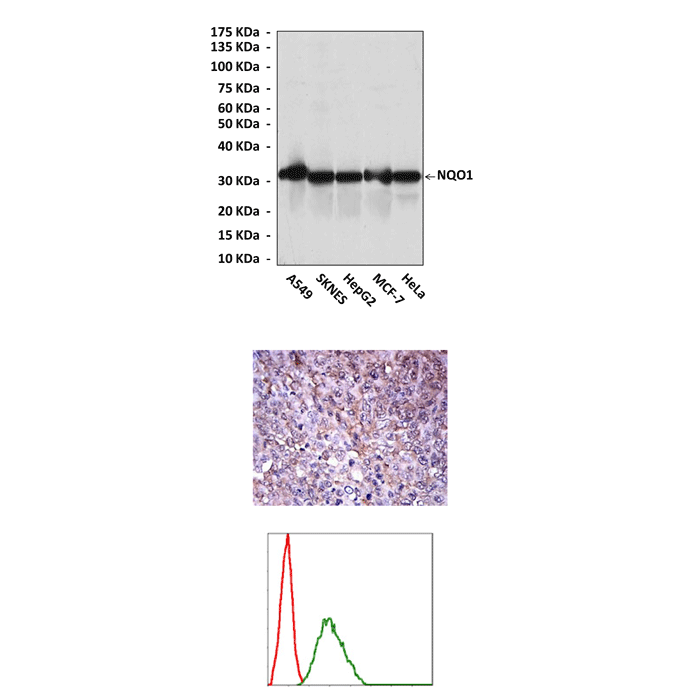Anti-NQO1: Mouse NQO1 Antibody |
 |
BACKGROUND NADPH:quinone oxidoreductase-1 (NQO1), also known as DT-diaphorase, menadione reductase, or quinone reductase 1, is a flavoprotein that catalyses the two-electron reduction of quinones and related compounds. Quinones, such as vitamin K or coenzyme Q10 are a chemical class containing a quinoid ring system as pharmacophore. Enzymes involved in cellular quinone metabolism catalyze mainly two different redox reactions. For example, NADPH:cytochrome P450 reductase can generate semiquinones by incomplete, one-electron reduction. Since semiquinones can react with molecular oxygen to generate reactive oxygen species (ROS), this process can lead to oxidative damage of cellular macromolecules, toxicity and mutagenicity. In contrast, NAD(P)H:quinone oxidoreductases (NQOs) are cytosolic flavoproteins that compete with P450 reductase and catalyze the reduction of highly reactive quinones and their derivates by complete, two-electron reduction, which results in the formation of relatively stable hydroquinones, often also referred to as quinols, and therefore avoids the formation of ROS. Thus, NQOs are considered key detoxifying enzymes which are induced by stressors such as xenobiotics or oxidants. Currently, NQO1 and NQO2, with substantial differences in substrate specificity and expression patterns, are described. While NQO1 uses nicotinamide adenine dinucleotide (phosphate) (NADH or NADPH) as electron donor, NQO2 shows a high preference for dihydronicotinamide riboside (NRH).1 In normal cells, NQO1 protects cells against redox cycling and oxidative stress, as well as against carcinogenesis by stabilization of the p53 tumor suppressor. It was demonstrated that NQO1 plays protective role against carcinogenesis in a mouse model with targeted disruption of the nqo1 gene. Furthermore, altered NQO1 expression has been reported in tumor cells from malignancies arising from the breast, colon, lung, liver, and pancreas. In human, a polymorphic form of the oxidoreductase exists, encoded by NQO1*2, which is characterized by a C609T substitution. NQO1*2 is a missense variant that is homozygous in 4.4%-20.3% of the human population and is associated with an increased risk of breast cancer. It was shown that the homozygous NQO1*2 genotype (P187S), which disables NQO1, is a strong adverse prognostic factor in patients with breast cancer. The presence of a homozygous C-T mutation at position 609 results in a loss of NQO1 protein and activity due to accelerated protein degradation (the half-life of mutant NQO1 is 1.2 hours) via the ubiquitin proteasomal system.2
The transcription of NQO1 is finely regulated by nuclear factor erythroid 2-related factor 2 (Nrf2), which transactivates an antioxidant response element (ARE) cis-acting element (5′-TGACNNNGC-3′) in the promoter region, in association with musculo-aponeurotic fibrosarcoma (Maf) proteins. Nrf2 proteins are a member of the Cap’n’collar family of basic region–leucine zipper transcription factors, and the basic region of Nrf2 is responsible for DNA binding to the ARE site. In unstimulated cells, Nrf2 is sequestered by Kelch-like epichlorohydrin (ECH)-associated protein 1 (Keap1) through the Neh2 domain and is finally subjected to ubiquitin-dependent proteasomal degradation. However, oxidative stress promotes nuclear accumulation of Nrf2 and activates transcription of NQO1. The external signals induced by detoxifying enzyme inducers or electrophilic compounds cause the liberation of Nrf2 from Keap1, resulting in the consequent activation and translocation of Nrf2 into the nucleus. Several kinases, including mitogen-activated protein kinases (MAPKs), protein kinase C (PKC), and phosphatidylinositol 3-kinase (PI3K) are involved in the activation of Nrf2 by phosphorylation.3
The transcription of NQO1 is finely regulated by nuclear factor erythroid 2-related factor 2 (Nrf2), which transactivates an antioxidant response element (ARE) cis-acting element (5′-TGACNNNGC-3′) in the promoter region, in association with musculo-aponeurotic fibrosarcoma (Maf) proteins. Nrf2 proteins are a member of the Cap’n’collar family of basic region–leucine zipper transcription factors, and the basic region of Nrf2 is responsible for DNA binding to the ARE site. In unstimulated cells, Nrf2 is sequestered by Kelch-like epichlorohydrin (ECH)-associated protein 1 (Keap1) through the Neh2 domain and is finally subjected to ubiquitin-dependent proteasomal degradation. However, oxidative stress promotes nuclear accumulation of Nrf2 and activates transcription of NQO1. The external signals induced by detoxifying enzyme inducers or electrophilic compounds cause the liberation of Nrf2 from Keap1, resulting in the consequent activation and translocation of Nrf2 into the nucleus. Several kinases, including mitogen-activated protein kinases (MAPKs), protein kinase C (PKC), and phosphatidylinositol 3-kinase (PI3K) are involved in the activation of Nrf2 by phosphorylation.3
REFERENCES
1. Das, A. et al: PLoS ONE 6:e20590, 2011
2. Wakai, T. et al: Int. J. Clin. Exp. Pathol. 4:363–70, 2011
3. Park, E.J. et al: J. Pharmacol. Sci.116:89–96, 2011
2. Wakai, T. et al: Int. J. Clin. Exp. Pathol. 4:363–70, 2011
3. Park, E.J. et al: J. Pharmacol. Sci.116:89–96, 2011
Products are for research use only. They are not intended for human, animal, or diagnostic applications.
Параметры
Cat.No.: | CP10435 |
Antigen: | Raised against recombinant human NQO1 fragments expressed in E. coli. |
Isotype: | Mouse IgG1 |
Species & predicted species cross- reactivity ( ): | Human, Mouse, Rat |
Applications & Suggested starting dilutions:* | WB 1:1000 IP 1:50 - 1:100 IHC 1:50 - 1:200 ICC n/d FACS 1:50 - 1:200 |
Predicted Molecular Weight of protein: | 31 kDa |
Specificity/Sensitivity: | Detects NQO1 proteins in various cell lysate. |
Storage: | Store at -20°C, 4°C for frequent use. Avoid repeated freeze-thaw cycles. |
*Optimal working dilutions must be determined by end user.
Документы
Информация представлена исключительно в ознакомительных целях и ни при каких условиях не является публичной офертой








